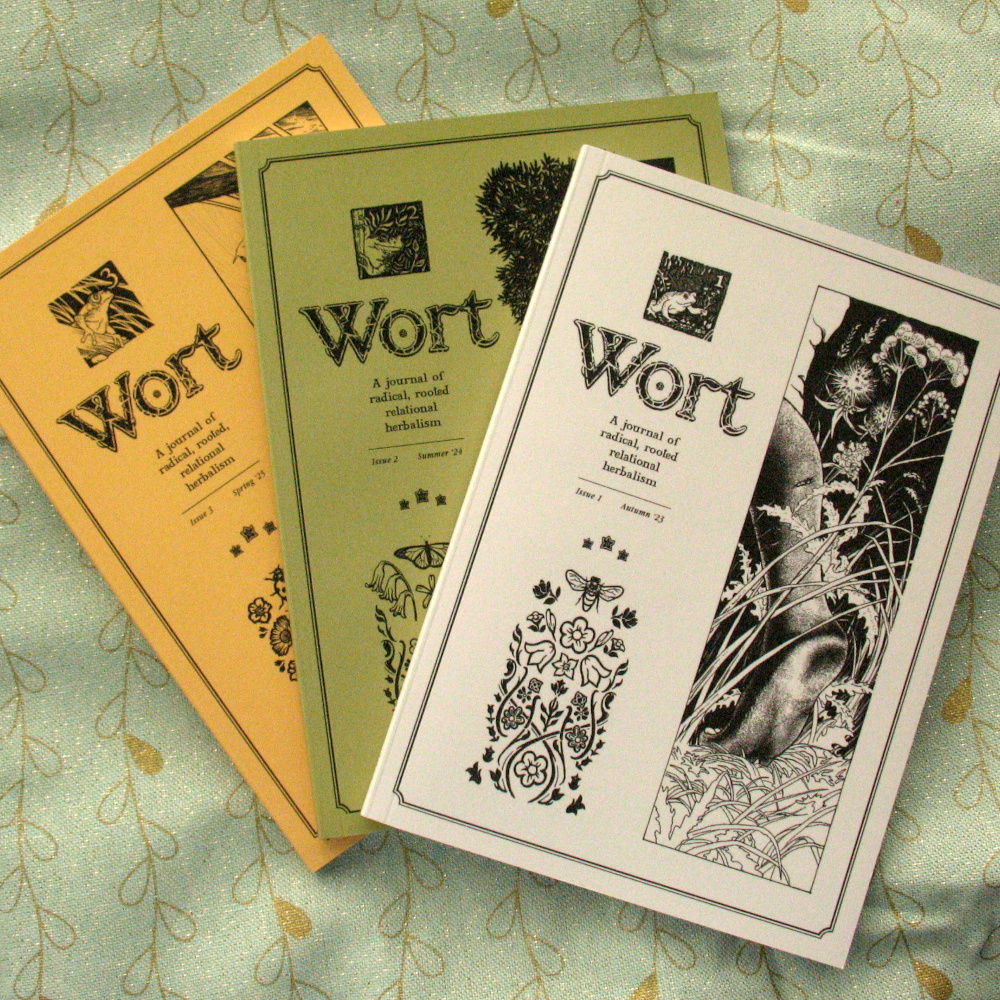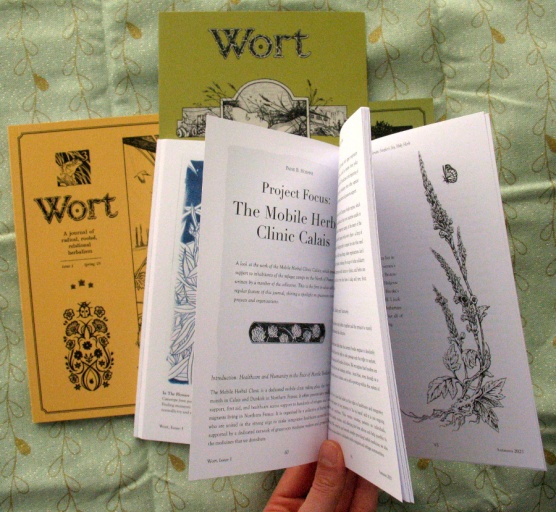This review was written by Nina Zina of Echo Zines for international zine month 2025 and was first published on their blog. Check out their website – going since 2001! – for a trove of resources, reviews and reflections on the themes of politics, witchcraft and (of course) zines!
Wort is a new journal all about herbalism from a radical and community-centred perspective. The first issue came out in Summer 2023, the second in Autumn 2024, and the most recent in Spring of this year. Each issue is a bit longer than 90 pages, printed in Wales, and created using open source graphic design software Scribus (I recommend trying Scribus yourself as an excellent alternative for Indesign). The journals are edited and produced by a small team and feature contributions from various authors and artists. I was asked for an honest review but to be actually honest, I have nothing but praise for the three issues of Wort Journal that I read. Perhaps just one thing that may bother some readers: the font of the texts is quite small, although I understand that choice may have been made to not waste paper and resources (and for me it was fine).
Really, it feels like a revelation to discover this journal. Its subject matter is 200% my cup of tea and I was pleasantly surprised by every essay I read: themes that feature heavily in the three issues are botany, herbalism, folklore, tarot, and intersectional activism which are some of my current main interests. Reading Wort, I’m grateful to learn about plants and how they relate to anti-colonial and anti-oppression struggles. I was excited to see mentions of authors like Leslie Feinberg, Nicole Rose (I’m reading their ‘The Prisoner’s Herbal’ book), and of course Robin Wall Kimmerer as well as the Missing Witches podcast and zinester Maranda Elizabeth. I found the language of all the texts easy to understand yet filled with lots of (new-to-me) information and insights. The artwork on the covers and inside is stunning. Some of it is made by featured artists who talk about their work as related to radical herbalism and and others by the journal team’s illustrator Ross Fleming.
Now I’ll focus on each issue: I recommend starting with issue number one because it contains introductions that are useful for those who are new to radical herbalism or eager to learn from new perspectives. For example, a history of folk herbalism, and how it was and still gets marginalised, and an extensive radical herbalism reading list that clearly shows the meaning of “radical” in Wort’s vision of radical herbalism. It includes publications about trans health, colonialism, disability justice, and radical mental health which shows that this journal isn’t just about individual health or academic plant knowledge, but about building community, collective healthcare, sharing different kinds of knowlegde, and fighting against oppression and the destruction of our planet. The holistic activist approach of Wort Journal is clear in the very indepth and honest essay about the Mobile Herbal Clinic that is active in the refugee camps in Calais, written by one of its volunteers. This project brings collective herbal medicine and practical support together with border abolition and egalitarian grassroots organising. Similarly, a short article about the history of abortion laws in Ireland connects this struggle to plants used to bring on abortion. I found the essay by Anja Van Geert about what consider when foraging very informative – I learned sooo much! – as it talks about things that aren’t often shared in herbalism books, such as the benefits of foraging (beyond free food), racist foraging laws, and how to forage ethically and safely. As someone who loves to get to know the plants that grow around me and sometimes pick them for food or medicine, this is a must-read introductionary text. I also very much enjoyed the deep dive into the Fool tarot card linked to daisy flowers and how they both symbolise and encourage resilience, rebirth, and childhood. Such deep dives help me to value and remember the qualities of specific plants and develop my own personal meanings. On top of all that, all throughout the issue, there is stunning artwork, from the drawings of abortifacients to beautiful illustrated herbal poetry and from the cyanotypes of Annie Randall to the Fool card as a daisy. So yes, issue one already got me hooked…
Issue number two is again filled with amazing artwork: from an interpretation of the Magician tarot card that I’d love to see expanded to an entire tarot deck to art experiments with woad as blue dye and of course several plant drawings in between. This issue has articles on seeds saving projects such as the Palestinian Heirloom Seed Library, the importance of certain plants in Palestine and how the Israeli occupier’s foraging laws restrict Palestinians’ access to these plants (I liked the author’s use of the word ‘Isnotreal’). Trees and herbs that are central to this issue are the oak tree and how it’s seen in Slavic folklore, Acorus Calamus, and Ginkgo and their wonderful beneficial uses. Each essay is very thorough and educative as well as inspiring and inviting to delve even deeper and go out to explore and take action.
I haven’t finished reading issue three yet but I’m looking forward to learning about Herbalista – a free mobile herbal clinic, the High Priestexx tarot card in connection with Viola, and the experimental Ruderal Garden in Sweden – and reading more lovely poems.
As you can tell, I’m eagerly devouring Wort journal and hope to spread the knowledge of their existence and appeal to you via this review. I’m very grateful to have received all three issues and I highly recommend reading them for yourself!
Find Wort Journal online and in various bookshops and distros.


